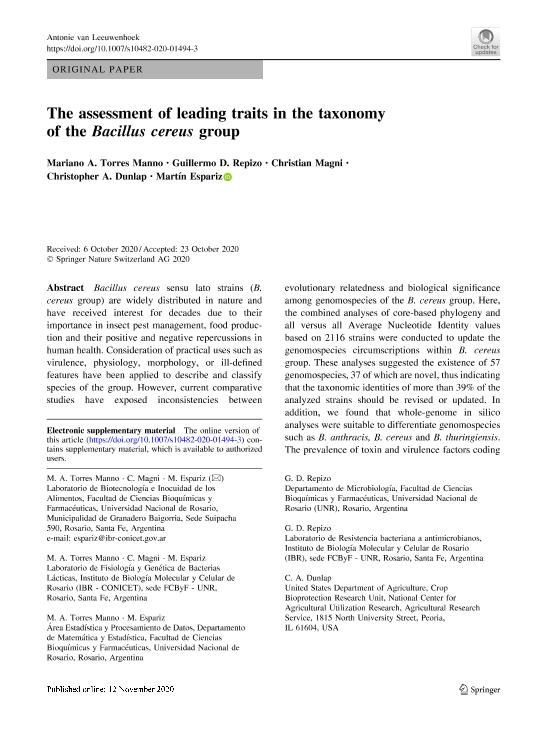Mostrar el registro sencillo del ítem
dc.contributor.author
Torres Manno, Mariano Alberto

dc.contributor.author
Repizo, Guillermo Daniel

dc.contributor.author
Magni, Christian

dc.contributor.author
Dunlap, Christopher A.
dc.contributor.author
Espariz, Martin

dc.date.available
2021-11-24T10:47:47Z
dc.date.issued
2020-11
dc.identifier.citation
Torres Manno, Mariano Alberto; Repizo, Guillermo Daniel; Magni, Christian; Dunlap, Christopher A.; Espariz, Martin; The assessment of leading traits in the taxonomy of the Bacillus cereus group; Springer; Antonie van Leeuwenhoek; 113; 12; 11-2020; 2223-2242
dc.identifier.issn
0003-6072
dc.identifier.uri
http://hdl.handle.net/11336/147273
dc.description.abstract
Bacillus cereus sensu lato strains (B. cereus group) are widely distributed in nature and have received interest for decades due to their importance in insect pest management, food production and their positive and negative repercussions in human health. Consideration of practical uses such as virulence, physiology, morphology, or ill-defined features have been applied to describe and classify species of the group. However, current comparative studies have exposed inconsistencies between evolutionary relatedness and biological significance among genomospecies of the B. cereus group. Here, the combined analyses of core-based phylogeny and all versus all Average Nucleotide Identity values based on 2116 strains were conducted to update the genomospecies circumscriptions within B. cereus group. These analyses suggested the existence of 57 genomospecies, 37 of which are novel, thus indicating that the taxonomic identities of more than 39% of the analyzed strains should be revised or updated. In addition, we found that whole-genome in silico analyses were suitable to differentiate genomospecies such as B. anthracis, B. cereus and B. thuringiensis. The prevalence of toxin and virulence factors coding genes in each of the genomospecies of the B. cereus group was also examined, using phylogeny-aware methods at wide-genome scale. Remarkably, Cry and emetic toxins, commonly assumed to be associated with B. thuringiensis and emetic B. paranthracis, respectively, did not show a positive correlation with those genomospecies. On the other hand, anthrax-like toxin and capsule-biosynthesis coding genes were positively correlated with B. anthracis genomospecies, despite not being present in all strains, and with presumably non-pathogenic genomospecies. Hence, despite these features have been so far considered relevant for industrial or medical classification of related species of the B. cereus group, they were inappropriate for their circumscription. In this study, genomospecies of the group were accurately affiliated and representative strains defined, generating a rational framework that will allow comparative analysis in epidemiological or ecological studies. Based on this classification the role of specific markers such as Type VII secretion system, cytolysin, bacillolysin, and siderophores such as petrobactin were pointed out for further analysis.
dc.format
application/pdf
dc.language.iso
eng
dc.publisher
Springer

dc.rights
info:eu-repo/semantics/openAccess
dc.rights.uri
https://creativecommons.org/licenses/by-nc-sa/2.5/ar/
dc.subject
AVERAGE NUCLEOTIDE IDENTITY
dc.subject
BACILLUS ANTHRACIS
dc.subject
BACILLUS THURINGIENSIS
dc.subject
COMPARATIVE GENOMICS
dc.subject
MULTILOCUS SEQUENCE ANALYSIS
dc.subject
PHYLOGENY-AWARE LINEAR REGRESSION MODELS
dc.subject.classification
Biología Celular, Microbiología

dc.subject.classification
Ciencias Biológicas

dc.subject.classification
CIENCIAS NATURALES Y EXACTAS

dc.title
The assessment of leading traits in the taxonomy of the Bacillus cereus group
dc.type
info:eu-repo/semantics/article
dc.type
info:ar-repo/semantics/artículo
dc.type
info:eu-repo/semantics/publishedVersion
dc.date.updated
2021-09-06T21:01:34Z
dc.journal.volume
113
dc.journal.number
12
dc.journal.pagination
2223-2242
dc.journal.pais
Alemania

dc.journal.ciudad
Berlin
dc.description.fil
Fil: Torres Manno, Mariano Alberto. Consejo Nacional de Investigaciones Científicas y Técnicas. Centro Científico Tecnológico Conicet - Rosario. Instituto de Biología Molecular y Celular de Rosario. Universidad Nacional de Rosario. Facultad de Ciencias Bioquímicas y Farmacéuticas. Instituto de Biología Molecular y Celular de Rosario; Argentina
dc.description.fil
Fil: Repizo, Guillermo Daniel. Consejo Nacional de Investigaciones Científicas y Técnicas. Centro Científico Tecnológico Conicet - Rosario. Instituto de Biología Molecular y Celular de Rosario. Universidad Nacional de Rosario. Facultad de Ciencias Bioquímicas y Farmacéuticas. Instituto de Biología Molecular y Celular de Rosario; Argentina
dc.description.fil
Fil: Magni, Christian. Consejo Nacional de Investigaciones Científicas y Técnicas. Centro Científico Tecnológico Conicet - Rosario. Instituto de Biología Molecular y Celular de Rosario. Universidad Nacional de Rosario. Facultad de Ciencias Bioquímicas y Farmacéuticas. Instituto de Biología Molecular y Celular de Rosario; Argentina
dc.description.fil
Fil: Dunlap, Christopher A.. United States Department of Agriculture; Estados Unidos
dc.description.fil
Fil: Espariz, Martin. Consejo Nacional de Investigaciones Científicas y Técnicas. Centro Científico Tecnológico Conicet - Rosario. Instituto de Biología Molecular y Celular de Rosario. Universidad Nacional de Rosario. Facultad de Ciencias Bioquímicas y Farmacéuticas. Instituto de Biología Molecular y Celular de Rosario; Argentina
dc.journal.title
Antonie van Leeuwenhoek

dc.relation.alternativeid
info:eu-repo/semantics/altIdentifier/url/http://link.springer.com/10.1007/s10482-020-01494-3
dc.relation.alternativeid
info:eu-repo/semantics/altIdentifier/doi/http://dx.doi.org/10.1007/s10482-020-01494-3
Archivos asociados
